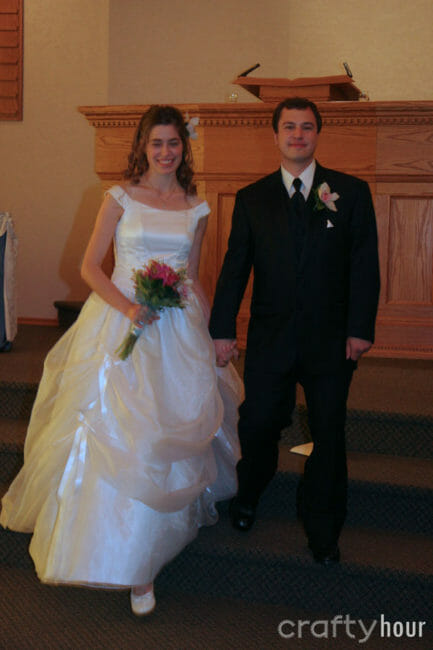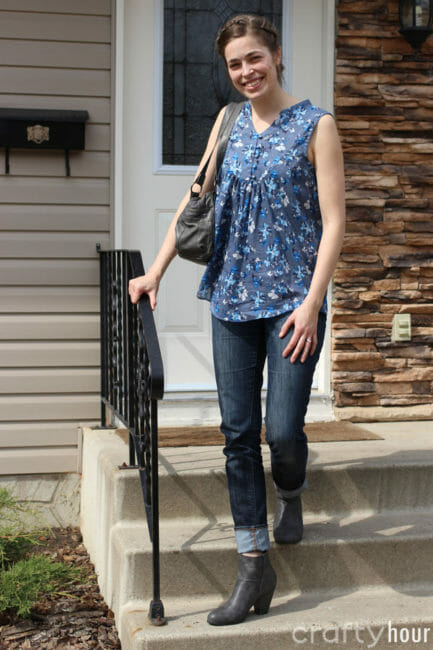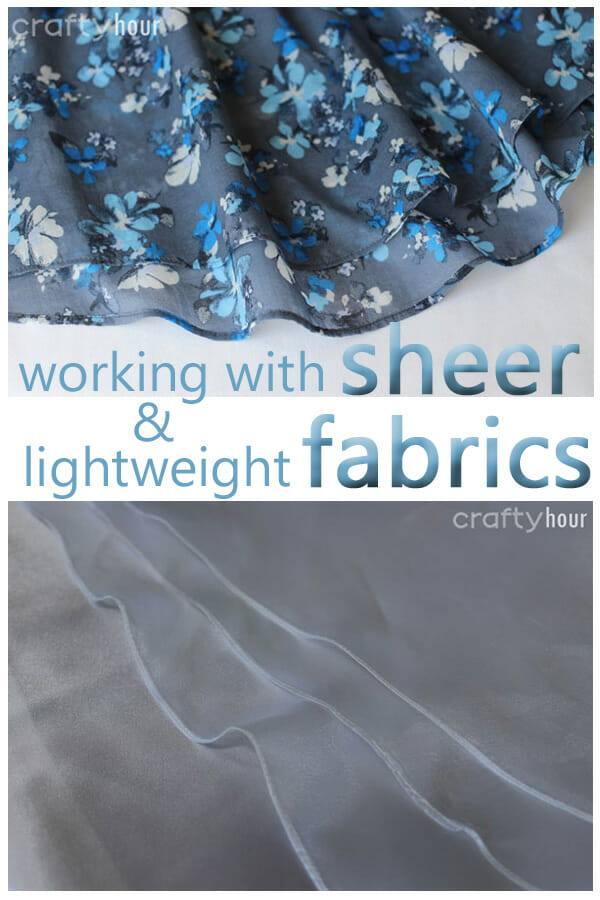Hello again from Laura at CraftyHour! I'm here today to share some of my favourite techniques for working with sheer and lightweight fabrics.
The first experience I ever had sewing any sheer fabrics was when I made my wedding dress 8 years ago. There was ample opportunity to learn – the dress had three overskirts of organza to seam and hem!

More recently I made my daughter a flower girl dress with an organza overlay and used some similar techniques to get a beautiful finish. The dress with more photos and details is blogged here.


Fabric types
So to begin with, let's talk about the sheer variety of fabrics out there (see what I did there?!). As I mentioned, the two dresses above were made with organza, a woven, very light, sheer fabric. Organza ravels easily and has a lot of body, not much drape. I used polyester organza, but it is also available in silk and nylon. Chiffon is another type of fabric that is woven, generally less transparent, and quite a bit more drapey than organza. Both of these are often used to make formal wear.
Another fabric that I love to use is voile, a gauzy, floaty fabric that is great for blouses, tunics, and scarves. Cotton voile, in particular, is ideal for summer garments. Similar in hand to voile is cotton silk, which I used to make this yoked tunic (details blogged here).


Voile, cotton silk, cotton batiste, and rayon challis are fabrics more suited to daily garments, as they are less transparent than true sheers and drape well. These are just some of the sheer and lightweight fabrics available.
Cutting
When cutting such lightweight fabrics, it's important to lay them out straight and square. Because they are less stable, these fabrics can shift around and cause a lot of off-grain moments when cutting! For the yellow organza I used for flower girl dress, I pinned the selvages together to keep the yardage from slipping around. I also used pattern weights and a rotary cutter and mat instead of pins and scissors.
Seams and hems
To finish hems and seams in a sheer or lightweight fabric, it's best to make them as narrow and tidy as possible. A narrow rolled hem is ideal, using either a serger or my preferred method, outlined below.
Run a line of basting stitches about 1/4″ from where you want your final hem to be.
Then using that line of stitching to fold crisply, press the raw edge up.
Next, using a basting stitch again, sew at about 1/8″ from the folded edge.
Carefully use a pair of scissors to trim the raw edge away very close to your second line of stitching.
Fold once again, enclosing the stitched-down raw edge, and press. Using a regular stitch length, stitch very close to the inside fold as your final line of stitching.


A serged rolled hem is what I used for the organza overlay on the yellow flower girl dress. Check your serger manual for the exact method for a narrow hem or rolled hem. Basically, you will need to disengage the stitch finger, increasing the lower looper tension, and decreasing the upper looper tension, with the left needle removed and only three threads. You'll need to play on scraps with this till you get the settings right.
The same basic idea of stitching, folding, stitching and trimming is used to make the tiny seams, as can be seen in this closeup of my wedding dress.
You will stitch the seam, right sides together, using about 1/4″ smaller of a seam allowance than called for. Then press the seam to one side, very close to the stitching, and stitch again. Trim close to the second stitching line, then fold once more to enclose the raw edge and stitch one final time. Tiny seam finished!




















Help, I love your articles BUT….. I live in Spain and items you recommend are not available here – do you know of English equivalent? I have not sewn for 35 years and now started again but SOOOOO nervous ( might be age ). I have done tailoring and complicated sewing in the past. Still got my amazing Bernina 830 Record immaculate but nothing like modern machines.
[…] are many ways to hem this blouse. I recommend checking out this tutorial, it has a few ways you can approach the hem for this project, choose the one you find most […]
Very informative and explained very well too. Thank you for doing this for all of us.
Beautiful…thanks for sharing the process so clearly.
Very much appreciated, thanks!
Very impressive. Thank you for sharing. I will try them right away.
Thank you for this helpful tip. Especially for those of us without serger machines.
Wow you made your wedding dress!
Pictures and directions well done.
Thank you for the very clear instructions. A few weeks ago I had to shorten my granddaughter’s bridesmaid dress and I had a nightmare job trying to do it with the special machine foot. I will use your method in future.
Love your teaching us how you do this. So very helpful!
Awesome instruction and your technique and end result is superb!
I went in a little nervous, no, very nervous. But you rocked it.
I’ll have no great worries now.
Thank you oodles!
Yes I have. I sewed two small jackets for two bride-friends and I did a special design. I am sorry that I don’t have any photos of them. The fabric was made of silk.
[…] If you are using silk or voile hemming might be a bit more difficult. Here is a tutorial that will show you a few ways to hem delicates fabrics. […]
Thanks for the excellent instructions. I have made a couple of wedding dresses and even bathing suits. I haven’t really sewn clothing for about 20 years. Quilting is my thing these days. But my daughter’s bridesmaid dress needed hemming. Why do they make dresses and pants so long? The only part that made me break out into a sweat was cutting the fabric close to the stitching line. One wrong snip and the dress would be ruined. But all’s well that ends well.
I am trying to hem lace dress overlay but can not use a rolled hem. Existing hem is approx half inch. Dress is a hi/lol style . Would appreciate any suggestions . Thanks in advance.
Thanks for the info!
Wait…. you made your own wedding dress??? It is beautiful.
I’m trying to get back into sewing after a long hiatus and came across this article when trying to learn how to sew with chiffon. Wedding dresses is something I’d like to get into. Great job and i look forward to learning from the techniques you have shared.
This question is slightly off-topic, but I’m hoping you will take mercy on me. I’m a huge novice at sewing and have an extremely simple project that is nonetheless a bit terrifying for me. I found your article searching on Google because I have some store-bought free-flowing shirts made from light-weight polyester fabrics that I need to do a SUPER simple alteration to and I’m looking for basic direction on working with those fabrics. I get the concept behind the alteration itself, but I’m so worried I will overlook something else about sewing these fabrics that might seem really obvious to an experienced sewer (like maybe failing to adjust the tension correctly or using the wrong thread or something? IDK!) and that my machine will eat my shirts because of my mistakes lol. Do you by any chance have any advice for me, or are there any other of your posts that you think I should check out? MANY many (many) thanks.
Hi Anne, sheer fabrics are certainly not a beginners fabric. It is normal to be terrified, I have been sewing for 20 years and now I have a state of the art sewing machine and I am also terrified of using it for fear of spoiling it. The best thing you can do is to practice on a piece of scrap fabric similar to the one on your project. The tension can only be adjusted once you have seen your stitches on a piece of fabric. My only other suggestion would be to use a Microtex needle, sold in any sewing or fabric store. This needle is ideal for fine fabrics such as the one you are attempting to tackle. Go slow aiming for accuracy, speed will come with time. If after sewing on a scrap of fabric you are unsure of the stitches send me a photo and I will send you instructions on how to adjust your sewing machine. Kind Regards, Mayra
Please help , i have. fabric with sequins. Needeles break what can i do? Ple
Hi Samaria, the best way to work with sequins fabrics is to take out the sequins where the stitching is to be done. If this is for one of those things that are to be worn once on a low budget play or a low budget Halloween costume perhaps you can sew over the sequins using a jeans or leather needle.
 ” rel=”noopener” target=”_blank”>
” rel=”noopener” target=”_blank”>
How would you hem a gown made of 95 poly and 4 spandex? It already has a small narrow hem but would you trim it and then make the same sort of hem the way you explained it. Thanks in advance
Yes, I would. Another way to do it is to serge the hem and then turn up just the serged edge and stitch. From the right side, all you will see is the straight stitching, from the inside you will see the serger stitching.
Great article Mayra! Love finding basics like this on the web to refresh my technique when I’m sewing with a fabric I’m not accustomed to (like the crinkle chiffon overlay on the bridesmaid dress I’m altering). Frankly, it’s nasty stuff….
Question for you–cotton silk is my FAVORITE and the print you used for your yoked tunic is fabulous! Do you have a source for cotton silk yard goods that you’d be willing to share?
Fabric.com always have some and right now a few colors on sale. White is very popular so I am not sure they are carrying at the moment with fall/winter around the corner, but it is always worth a try. Hope you find it, it is great stuff.
Hello,
So I’m working with sheer fabrics for the first time and I was wondering, how do I attach long skirt panels without it looking really bad??
-tori
Hi Tori, the best stitch for attaching different panels to a sheer fabric is the use of the french seam. You need to consider the grain line as well. But, I will appreciate a photo to see what is in your mind, my email is mayra@so-sew-easy.com
I feel ready to tackle my daughter’s prom dress. Thanks for the tutorial.
Thanks for the tutorial on hemming sheer fabrics. What special considerations are there when using French seams and rolled hems in the same garment. Do you roll the hem first or sew the seams first?
What fabric are you using?
I agree w Carol above. I would just make French seams. I think the method given for hemming is more likely to be successful than using the narrow hem foot.
i spray my material with hairspray and let it dry then i have a workable material .when i am done i just rins out and dripdry.
Wonderfully informative
I am having significant trouble stitching a narrow hem on Silk chiffon. I’m trying to use a rolled narrow hem foot which I have just used on some silk organza and it worked perfectly. The stitches pull and skip on the chiffon. I switched to a size 9 needle – no better. Any suggestions? Should I be using special thread for chiffon?
I would personally never use that foot unless is cotton voile or organza, Silk chiffon is very difficult to work with. The only method that i know that work well even on a curve is to sew a stitching line all around your hem at 1/4″ then fold and iron, then trim half of the seam allowance and fold back up again and stitch very close to the edge, that should give you a very narrow hem.
Thank you for sharing!
Also Use a size 9 or 11 needle for sheer fabrics.
fI thought you might want to mention that you should use a size 9 or 11 needle for sheer fabrics.
I am very short & tunics look ridiculous on me. Shirts look much better if I shorten them. I’m afraid to shorten thin fabrics like silk, and I’m not a great seamstress. I was wondering how attaching a fabric trim to the bottom edge would work & then cutting the fabric at the seam behind it. The trim would then be the bottom hem.
I think it will work just fine, as long as you realize that the focus point will be the trim, if you do not want this try to find a fabric that blends well with the rest of the shirt. A satin binding could work for you, but you need to go very slow to get this done. I think this would make a good tutorial topic I will keep it in mind. Some Tunics can be worn with a nice belt around the hip bones, and if you lift your arms the fabric bunches a bit around the waist, but yes the tunic can not be too long for short people like me, I am 5″1. So I totally get you!
I am hemming s bridesmaids dress withsimilarly sheer fabric. To make sure i dont ruin it i am going to alstitch a matching velvet ribbon BEHIND the sheer fabric to create an encased &slightly weighted hem, and then stitch above it and trim the excess. Basically like putting a rope in the bottom and encasing it like a baby carried by a stork.
Sounds Lovely! Load up a picture so I can see, please:)
This is very interesting and I do have some questions I hope you can answer.
1) I am nervous that the teeth that moves the fabric forward as one sew will chew up such delicate materials. Any tips to avoid that ?
2) What size needle and what type of thread is best to handle such material ? Had wondered if wrong size needle will damage delicate fabrics.
3) Any particular tension and stitch length would be best for this type of project ?
I am thinking of just heming a prom dress. Thanks.
Thank you Lili for sharing, yes some people do prefer this method, I am of the opinion that whatever works for you and it is the easiest is definitely the best. Interestingly enough I have seen this method on mass produce garments.
Thank you! This has been very helpful, as I have never sewn on organza before, and I am attempting to make my daughter’s wedding dress.
Great tutorial! Thank you.
This is a wonderful article on hemming sheer fabrics. I have tried many methods, and I agree that the first method has always given me the best results. HOWEVER, I can never find an article on how to mark the hem before cutting. Could you please see what you could find for that method. Is it best to have them stand on a stool, or mark from the floor. I am talking about prom/bridesmaids dresses. There are usually 3 layers. I tend to still leave the sheer layer longer than I like because I am afraid to cut too much off. The original top layer is usually so out of shape that you can’t just mark 3″ off all around and have a nice hem.
I usually have the gal stand straight with arms at side looking forward. Very important she does not look down. Make sure all dress layers are pulled down and lying well on the gal before pinning. I then determine the length of her dress. I get my starting point by pinning to the floor and leaving about a fingers width from that point. Once I have done that I will cut off leaving about 2 or 3 inches from my pins. You need to get rid of the excess fabric. It may be easier if you and the gal would like to leave a slight train and then find a spot at the side seam and work out from there. This way you only need to worry about the front and gradually taper the fashion fabric into the train. Then just turn up the fabric where you have marked your pins. I usually allow a slight drape of a finger width for the dress to lay on the floor. Do the same with the liner, but make it a bit shorter than the fashion fabric. Have the gal walk in her dress to see how she feels with the length and that is all there is to it. Just do the rolled hem. Do this procedure on a low piled carpet or a hardwood or linoleum floor. A low pile carpet allows you to spread the dress out and the carpet kind of holds the dress in place for pinning and cutting excess fabric from the dress. Then you move around the dress while the gal keeps her pose.
Thanks for these good ideas!
Thank you
Interesting article, and the finished seams above look wonderful. Three questions (for anyone who would like to jump in!):
1) What weight thread seems to work the best?
2) The technique shown for making seams involves stitching the seam three times. So as above, I wondered about thread weight, and also why not use a regular French seam? I’m honestly wondering – would only only two rows of stitching be too weak? In the method above the seam ends up enclosed the same way, but has been stitched twice before the final seam is sewn.
3) I’m reading the instructions incorrectly I think – sew the first seam right sides together. Then press the seam allowance over to one side and stitch through those three layers of fabric and trim away excess. At this point the right side would be smooth with an extra line of stitching visible but seam allowances still on the inside/wrong side of fabric. Then fold over and enclosed the trimmed seam allowance and stitch together. Doesn’t this end up with the enclosed seam allowance to the right side of the fabric? If not, where am I making a mistake?
Thank you so much, I look forward to trying these out, and learning how to sew with some of these more delicate fabrics.
Hi, I’ve also used these methods for light to medium weight linen fabrics too.
thank you